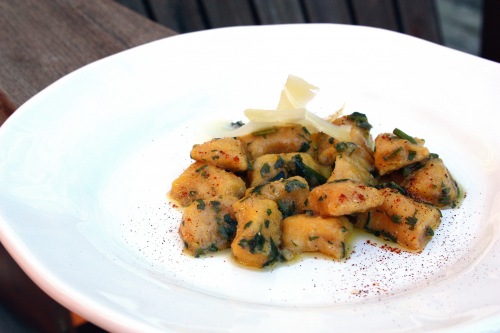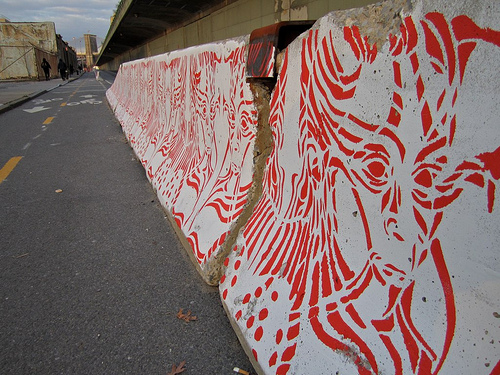 Debra Hampton’s stencils are a bright spot on a gloomy stretch of bike path.Photo: Sarah GoodyearI was out for a run the other day when I came upon a team of people stenciling a design on the Jersey barriers that protect a new bike lane not far from where I live.
Debra Hampton’s stencils are a bright spot on a gloomy stretch of bike path.Photo: Sarah GoodyearI was out for a run the other day when I came upon a team of people stenciling a design on the Jersey barriers that protect a new bike lane not far from where I live.
I stopped to ask what they were up to, and it turned out the artist responsible for the piece was standing right in front of me. Her name is Debra Hampton.
I didn’t have my camera on me at the time, but went back later to take pictures of the completed work, which adds some beautiful color and visual interest to a kind of bleak section of the protected bike path connecting two parts of the waterfront Brooklyn Bridge Park.
Later I followed up with Hampton on the phone, and she explained that this was her first foray into public art. It was a mere three weeks from the time her proposal was accepted for the project to the time it was completed.
“I was really impressed that during the economic downturn, a public art program like this exists,” said Hampton, who lives and works in Queens and was unfamiliar with the site until she scouted it. She said the city gave her $500 for materials and also covered the cost of the paint; she received a “small stipend.” The actual painting of the 600-foot section of barriers was done by a team of volunteers from New York Cares.
The project was one of three Jersey barrier beautification sites funded by the New York City Department of Transportation’s Urban Art Project. Founded in 2008, it is a relatively cheap, quick way to improve some of the city’s public spaces, as well as giving local artists a venue. The projects have a truly authentic DIY feeling that’s in the city’s great tradition of street art.
Hampton said she got great feedback from neighborhood residents as the painting was being done. And she said she was happy to be able to improve one of the city’s bike lanes. “I am one of those people who wants to ride my bike, but I don’t always feel safe,” she said. “It was great to be able to be part of giving bike lanes more visibility and community.”
It’s a small thing, true. And it doesn’t eliminate the fumes and noise from traffic speeding by on the other side of the barrier. But given the importance of beauty in people’s feelings about their city, the DOT’s money is well spent here. Now, every time I run or ride past what used to be simply battered white pieces of concrete, I’m going to feel a little bit happier. It’s one of the things I am thankful for this season.



